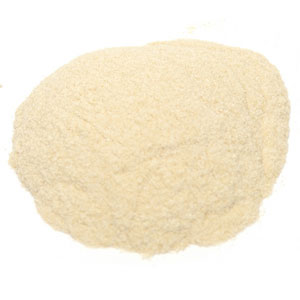Pectin
Pectin is a complex polysaccharide found in the cell walls of plants, where it plays a crucial role in providing structural support. It is particularly abundant in the fruits of plants, where it helps to maintain the plant's shape by forming a gel-like matrix in the cell walls. Pectin is a key ingredient in the food industry, primarily used as a gelling agent in the production of jams and jellies, and is also found in a variety of other food products such as desserts, candies, and as a stabilizer in fruit juices and milk drinks.
Chemical Structure and Properties[edit | edit source]
Pectin is a heteropolysaccharide, composed mainly of galacturonic acid units linked together through α-(1→4) glycosidic bonds. The degree of methylation (DM) of the carboxyl groups of the galacturonic acid units affects the gelling properties of pectin. Pectins are classified into two major categories based on their degree of methylation: high-methoxyl (HM) pectin, which requires sugar and acid to form gels, and low-methoxyl (LM) pectin, which can gel in the presence of calcium ions without the need for sugar and acid.
Sources and Extraction[edit | edit source]
Pectin is extracted from plant sources, with apples and the peels of citrus fruits being the primary commercial sources. The extraction process typically involves treating the plant material with hot dilute acid, which solubilizes the pectin and allows it to be separated from the plant material. The extracted pectin is then purified and dried for commercial use.
Applications[edit | edit source]
Food Industry[edit | edit source]
In the food industry, pectin is widely used for its gelling, thickening, and stabilizing properties. It is a key ingredient in jams and jellies, where it helps to create the desired texture. Pectin is also used in a variety of other food products, including fruit-based preparations for yogurts, desserts, and confectionery items like gummy candies. In beverages, pectin can help to stabilize the suspension of fruit pulps in juices and milk drinks.
Pharmaceutical and Medical Uses[edit | edit source]
Pectin has applications in the pharmaceutical and medical fields as well. It is used as a source of dietary fiber, which can help to regulate digestion and has been shown to have a beneficial effect on cholesterol levels. Pectin-based formulations are also used in wound care products, where its gel-forming properties can help to protect and heal the wound.
Health Benefits[edit | edit source]
Pectin is recognized for its health benefits, particularly in terms of digestive health. As a soluble fiber, pectin can help to regulate bowel movements and has been shown to have a prebiotic effect, promoting the growth of beneficial bacteria in the gut. There is also evidence to suggest that pectin may help to lower LDL cholesterol levels, contributing to cardiovascular health.
Environmental Considerations[edit | edit source]
The extraction and production of pectin from plant materials can have environmental impacts, particularly in terms of water use and the management of waste products. However, efforts are being made to improve the sustainability of pectin production, including the development of more efficient extraction methods and the utilization of waste materials from other food production processes as sources of pectin.
| This article is a stub. You can help WikiMD by registering to expand it. |
Search WikiMD
Ad.Tired of being Overweight? Try W8MD's physician weight loss program.
Semaglutide (Ozempic / Wegovy and Tirzepatide (Mounjaro / Zepbound) available.
Advertise on WikiMD
|
WikiMD's Wellness Encyclopedia |
| Let Food Be Thy Medicine Medicine Thy Food - Hippocrates |
Translate this page: - East Asian
中文,
日本,
한국어,
South Asian
हिन्दी,
தமிழ்,
తెలుగు,
Urdu,
ಕನ್ನಡ,
Southeast Asian
Indonesian,
Vietnamese,
Thai,
မြန်မာဘာသာ,
বাংলা
European
español,
Deutsch,
français,
Greek,
português do Brasil,
polski,
română,
русский,
Nederlands,
norsk,
svenska,
suomi,
Italian
Middle Eastern & African
عربى,
Turkish,
Persian,
Hebrew,
Afrikaans,
isiZulu,
Kiswahili,
Other
Bulgarian,
Hungarian,
Czech,
Swedish,
മലയാളം,
मराठी,
ਪੰਜਾਬੀ,
ગુજરાતી,
Portuguese,
Ukrainian
Medical Disclaimer: WikiMD is not a substitute for professional medical advice. The information on WikiMD is provided as an information resource only, may be incorrect, outdated or misleading, and is not to be used or relied on for any diagnostic or treatment purposes. Please consult your health care provider before making any healthcare decisions or for guidance about a specific medical condition. WikiMD expressly disclaims responsibility, and shall have no liability, for any damages, loss, injury, or liability whatsoever suffered as a result of your reliance on the information contained in this site. By visiting this site you agree to the foregoing terms and conditions, which may from time to time be changed or supplemented by WikiMD. If you do not agree to the foregoing terms and conditions, you should not enter or use this site. See full disclaimer.
Credits:Most images are courtesy of Wikimedia commons, and templates, categories Wikipedia, licensed under CC BY SA or similar.
Contributors: Prab R. Tumpati, MD


